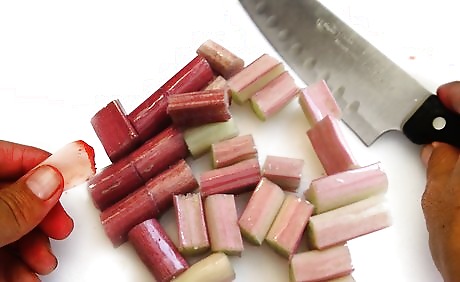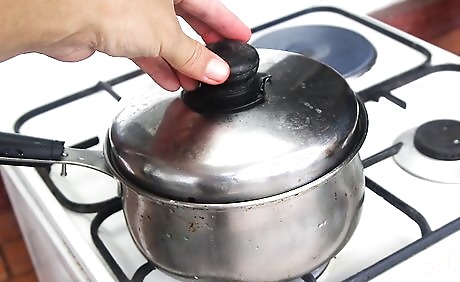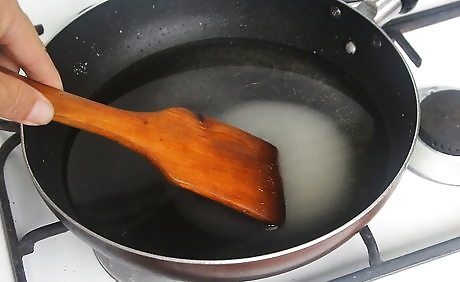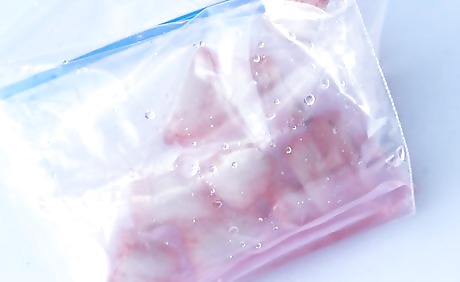
views
Washing and Trimming the Rhubarb

Trim off the leaves and tips. Place the rhubarb stalks on a flat surface, like a cutting board. Trim off the top of the stalks where the leaves are. Make sure you remove all the leaves, as these are poisonous. Trim off the bottom inch (2.5 cm) of the stalks as well, where the rhubarb was touching the ground.

Wash and dry the rhubarb. Rinse the rhubarb under cool, running water. Use your fingers or a clean cloth to scrub away any dirt on the fruit. Rhubarb is fairly hard, so you can also use a vegetable brush to scrub it clean if you like. Lay the stalks on a clean towel and roll each stalk around to dry it. You can also dry the rhubarb in a salad spinner if you have one.

Chop the stalks into bite sized pieces. Transfer the rhubarb stalks back to the cutting board. Chop each stalk into quarter- to half-inch pieces (6 to 13 mm). Smaller pieces are ideal for jams, pie fillings, and baked goods. Larger pieces are better for eating plain or making chunkier compotes. If you have specific plans for the rhubarb, consult the individual recipes to determine the right length for the pieces.
Dry Packing Rhubarb

Boil the rhubarb in water for one minute. Fill a large saucepan with water. Put on a lid and bring the water to a boil over medium-high heat. When the water is boiling, carefully transfer the rhubarb to the water. After a minute, remove the pan from the heat and strain the rhubarb into a colander. Blanching the rhubarb will help preserve its color and flavor better, and for a longer time. Blanching is the process of boiling something for a very short time and then plunging it into an ice bath to stop the cooking process.

Plunge the rhubarb into an ice bath. Fill a large mixing bowl halfway with ice, and fill the bowl the rest of the way with water. Pour the strained rhubarb into the icy water and leave it for a minute. This will stop the cooking process. When blanching, always leave the food in the ice bath for the same amount of time that you boiled it.

Dry the rhubarb. Strain the rhubarb in the colander again, and pick out any ice cubes that fall in as well. Lay the rhubarb pieces on a dry towel to air dry for a few minutes, or run them through the salad spinner to remove the water.

Freeze the pieces on a baking sheet. Transfer the rhubarb to a baking sheet, and spread the pieces out so they're in a single layer. This will help the rhubarb freeze faster and at an even rate. Place the baking sheet into the freezer and close the door. Leave the rhubarb pieces to freeze for at least two hours. Freezing the rhubarb in a single layer will ensure the individual pieces don’t get stuck together, which will make it easier to measure and portion the rhubarb when it’s frozen.

Transfer the rhubarb to a freezer container for long-term storage. When the rhubarb pieces have had time to freeze, remove the baking sheet from the freezer. Move the rhubarb pieces to a freezer bag. Don’t fill the bag more than two-thirds full. Push all the air out of the bag to prevent freezer burn, and seal the bag tightly. Transfer the bag to the freezer for long-term storage. You can write the date on the rhubarb if you want to keep track of how long it’s been in the freezer. Rhubarb frozen in this manner will keep for about a year.
Syrup Packing the Rhubarb

Make a simple syrup. In a medium saucepan, combine 2 cups (450 g) of sugar and 4 cups (940 ml) of water. Bring the mixture to a boil over medium heat, stirring regularly. When the sugar has fully dissolved, remove the pan from the heat. You need enough simple syrup to cover the rhubarb. Depending on how much rhubarb you have, you may need to make more syrup. Use the two parts water to one part sugar ratio.

Cool the syrup. Set the syrup aside and let it cool for about an hour, until it’s near room temperature. Then, transfer the pan and the syrup to the refrigerator and let it chill for at least another hour. It’s important that the syrup is thoroughly chilled before you combine it with the rhubarb.

Combine the cooled syrup and rhubarb. Transfer your rhubarb pieces to a large mixing bowl. Cover the fruit with the simple syrup, and stir the mixture to completely submerge the rhubarb in the syrup. Freezing the rhubarb in a simple syrup solution will help to preserve the color and flavor. Instead of simple syrup, you can also cover the rhubarb with apple, peach, or white grape juice.

Transfer the mixture to a freezer-safe container. Pour the rhubarb and syrup mixture into your freezer bag, leaving at least an inch (2.5 cm) of head room for expansion. Seal the container tightly to make it air-tight. Ideal containers for syrup packed rhubarb are freezer-safe plastic containers or freezer bags.

Freeze the syrup-packed rhubarb. Transfer the container to the freezer and leave the rhubarb to freeze for several hours. You can date the container to help you keep track of when the rhubarb went into the freezer. Syrup or juice packed rhubarb will last in the freezer for about a year.




















Comments
0 comment